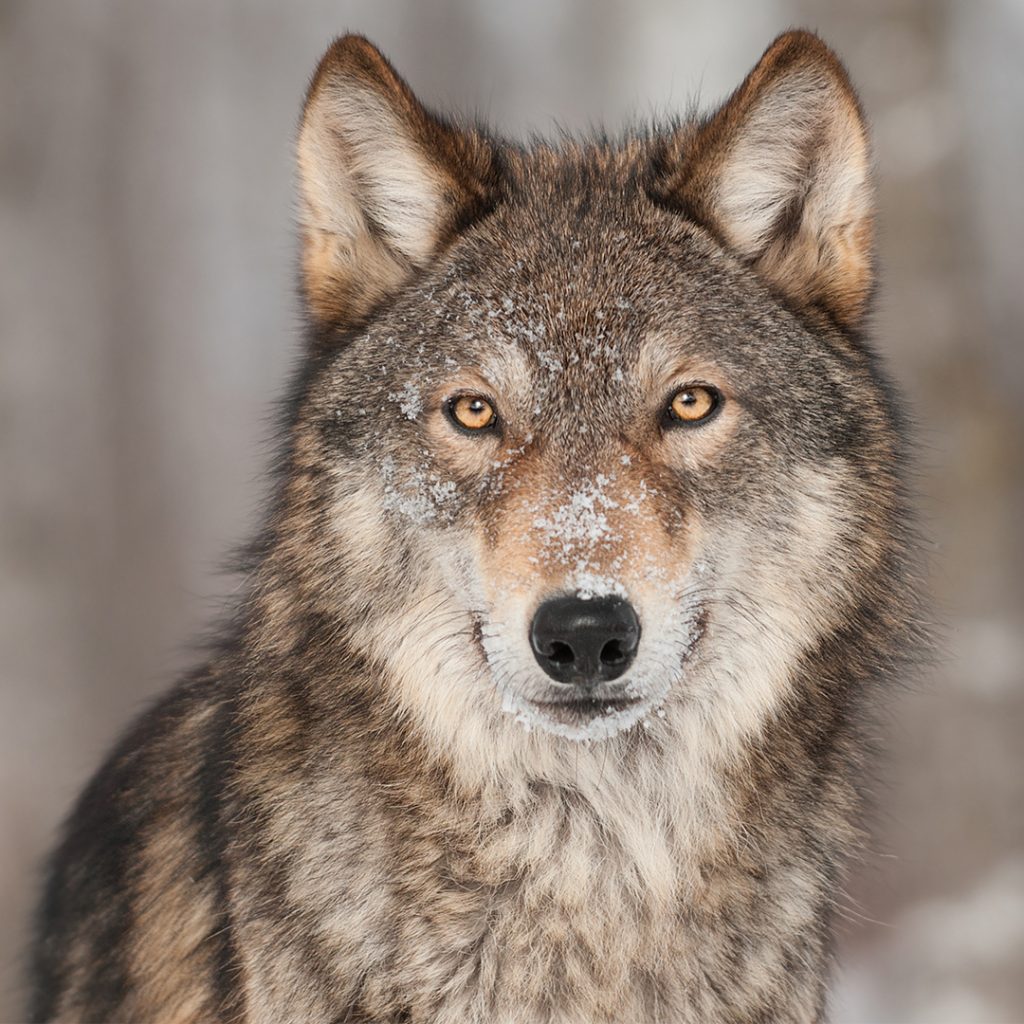October 7, 2020
Wolf Reintroduction 101
Answers to Your Questions About the Possible Reestablishment of Wolves to Colorado
By Brian Aucone, Senior Vice President for Animal Sciences
As a wildlife conservation organization whose mission is Inspiring Communities to Save Wildlife for Future Generations, we want to ensure you’re informed when casting your vote on wildlife-related issues. On Nov. 3, you’ll have an opportunity to vote “yes” or “no” on if the grey wolf should be reestablished in Colorado. As with any decision like this, there are proponents and opponents to this idea. We hope the following information helps you—members of our collective community—understand what this proposition means.

Photo courtesy of Colorado State University's Center for Human-Carnivore Coexistence.
What’s on the ballot regarding wolves?
Under Proposition 114, the Colorado Parks and Wildlife Commission would be required to:
- Develop a plan to restore grey wolves in Colorado using the best scientific data available.
- Hold statewide hearings to obtain public input.
- Take the steps necessary to begin reintroduction of wolves by December 31, 2023 on designated lands west of the Continental Divide.
- Oversee grey wolf restoration and management.
- Distribute state funds to assist livestock owners in preventing and resolving conflicts between wolves and livestock.
- Distribute state funds to pay fair compensation to livestock owners for losses caused by wolves.
- Not impose any restrictions on private landowners regarding land, water, or resource use.
The Colorado Parks and Wildlife Commission is a governor-appointed board of 11 citizens that oversees Colorado Parks and Wildlife (CPW), a state agency.
Why should we bring wolves to Colorado?
Wolves are a natural apex predator that has been missing from Colorado since the late 1940s, when the last known wolf was shot in southwest Colorado. They are part of a healthy ecosystem and reestablishing them will help restore a natural balance that has been missing. Wolves in Colorado could also help create a connection to the wolves in New Mexico/Arizona and those in the Northern Rockies, two populations that are currently separated.
Are wolves a threat to humans?
Wolves are very shy and elusive animals. Most people don’t even see wolves when they are in areas with robust populations. Wolf attacks can happen, but they are extremely rare. Between 1900 and 2000, in Alaska and Canada, where over 60,000 wolves live, there were only 16 documented bites by wolves—only six were considered serious and none were life threatening. An additional 12 reported cases were from animals believed to be rabid. There have been no reported deaths by wolves in North American from 1900 to 2000.
Are wolves a threat to pets?
Like other large carnivores, such as bear, birds of prey, and mountain lions, wolves may kill pets if they encounter them. Wolves typically avoid residential areas and most encounters with pets occur in remote regions when a pet is not leashed and comes upon a wolf or a den, which is extremely rare. There are diseases that are common between dogs and wolves, though scientists believe it is far more likely for dogs to spread disease to wolves than for wolves to spread disease to dogs.
Are the wolves being proposed to reestablish a different species than those that were originally here?
No, the grey wolf, Canis lupus, is one species, with several subspecies depending on geographic location. The wolves proposed to be reestablished to Colorado will be from more northerly populations here in the U.S. and Canada. Historically, wolf populations were contiguous and their restoration in Colorado will potentially connect northern and southern populations, a link that was broken when wolves were wiped out from Colorado.
Are there disease issues with wolves that humans should be concerned about?
Wolves can carry hydatid disease, a parasitic organism that humans can contract. This can also be carried by pet cats and dogs, wild ungulates, and livestock, which is where most transmission to humans occurs. It is transmitted by contact with fecal material from an infected animal. Direct human infection from wolves is highly unlikely, and transmission from wolves would only occur if you have direct contact with wolf feces or a dead wolf.
Will wolves affect the numbers of elk and deer available for hunters?
Wolves primary prey are deer and elk, which they have to chase down. Studies have shown that they prey primarily on the older and weak individuals who otherwise might have died from disease or old age. While the presence of wolves may make prey warier for hunters, increasing wolf numbers in Idaho, Wyoming, and Montana, has not shown significant decline in elk populations in 20 years. One predictive model shows that wolves may help decrease elk and deer with chronic wasting disease, which could increase the health of those populations. Chronic wasting disease has a negative impact on elk and deer populations and is found in populations through most of the state. These animals are in a weaker state and easier for wolves to hunt down, thus it is believed they could help reduce the number of elk and deer with this affliction.
Will wolves hunt livestock like cows, goats, and sheep?
Yes, wolves will occasionally kill and eat livestock. In Montana, Wyoming, and Idaho, where wolves were introduced and established over 25 years ago, wolves account for less than 1 percent of the annual gross income from industry wide livestock operations. The current reintroduction plan would compensate ranchers for any livestock loss or injury proven to be from wolves. Additionally, there are also a number of management tools for ranchers to reduce conflict with wolves that funding and training are also being proposed.
Are there already wolves here in Colorado?
Since the introduction of wolves in the greater Yellowstone ecosystem, wolves have occasionally wandered into northwestern Colorado but none have ever established in the over 25 years since. Most recently a small pack wandered into Colorado and even had a litter of pups. At this point it is not clear that they will stay here and scientists do not believe that these small numbers will allow a reestablishment of a sustainable population in Colorado.
Will wolves be hunted if they are reestablished in Colorado?
It is possible, once wolf numbers reach a sustainable level, that hunting permits could be issued to keep the populations numbers in line with the overall ecosystem needs, much like we regulate deer and elk populations.
Will this cost taxpayer’s money to reestablish wolves and support them?
Yes, tax money that currently supports Colorado Parks and Wildlife will be used to reestablish wolves to Colorado and to reimburse farmers for proven loss to livestock. The bill does not result in tax increases and is planned to be funded within the budget of Colorado Parks and Wildlife. Once wolves are reestablished, funding is expected to be primarily for population monitoring, management, and reimbursement for any livestock loss.
Can Colorado support wolves?
Yes, Colorado has expansive public lands—more than 17 million acres—to maintain healthy populations of wolves. Additionally, their primary prey, deer and elk, are in abundance which is the most important factor for wolves to be successful.
Where will wolves be introduced in Colorado?
There are more than 17 million acres of public land in Colorado. It is likely, due to habitat type and prey availability, that the introductions would occur in the mountains of northwestern Colorado. This ballot measure leaves the specific planning on where reestablish wolves to Colorado Parks and Wildlife and the United States Fish and Wildlife Service.
Are grey wolves an endangered species?
Yes, the grey wolf, Canis lupus, is currently an endangered species under the Endangered Species Act of 1966, and were listed as endangered in 1973.
Brian Aucone, who is Denver Zoo’s Senior Vice President for Animal Sciences, is co-hosting a webinar titled, “Wolf Restoration in Colorado: What Can We Learn from Yellowstone” along with Colorado State University’s Center for Human-Carnivore Existence on Oct. 14. Click HERE for more information and to register, and HERE for more information about on the topics covered in this article.
-
 April 15, 2024
April 15, 2024Good Luck, Chuck!
Good Luck, Chuck! Beloved Bachelor Relocating as Part of Asian Elephant Species Survival Plan In a heartfelt and collaborative…
-
 April 15, 2024
April 15, 2024African Impact
African Impact Two New African Field Conservation ProgramsAim to Protect Gorillas + Grey Crowned Cranes We're honored to provide…
-
 March 1, 2024
March 1, 2024Last Place(s) on Earth
Last Place(s) on Earth New Asian Field Conservation Programs Protect Asian Elephants, Sumatran Orangutans + more Indonesia's Leuser Ecosystem…

